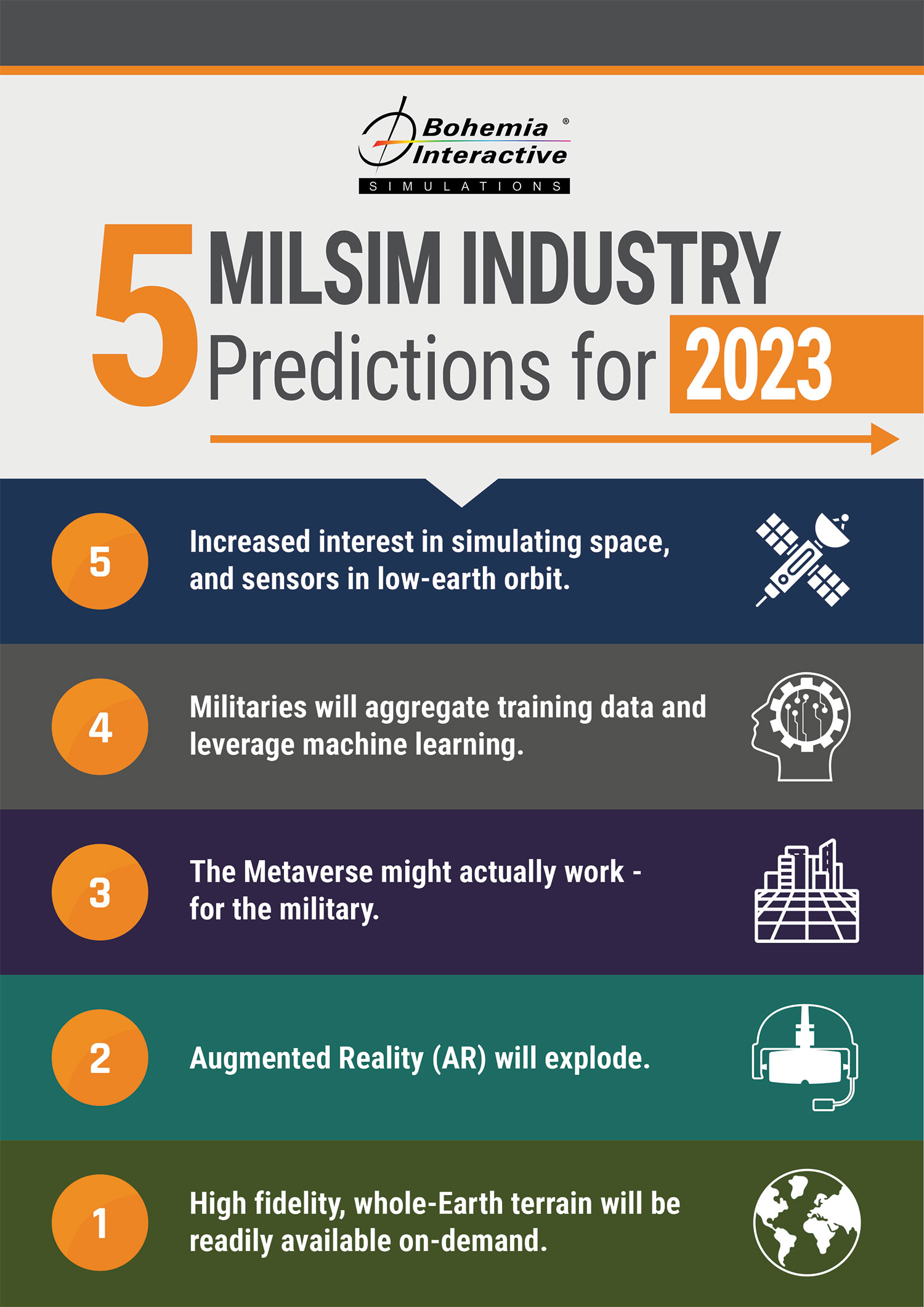By Pete Morrison, Chief Product Officer
The growing complexity of modern warfare has led many defense organizations to focus on interoperability, automation, and artificial intelligence. Here are BISim’s predictions on some of the trends that will shape military simulation (milsim) investment in 2023, as premier western military organizations strive to prepare their forces for combat in a new era.
#5: Increased interest in simulating space, and sensors in low-earth orbit.
In 2023, we'll see increased interest in space. The fragility of commercial satellite networks has become obvious given recent threats by potential aggressors, and we are seeing more and more demand for space-related simulation and visualization.
BISim has heavily invested in simulation and rendering technology that supports space. Our new VBS Blue engine supports high-fidelity rendering of multiple planets - even though our customers are still a few years away from training combat forces for deployments to the Moon, or Mars!
#4: Militaries will aggregate training data and leverage machine learning.
Most military organizations use military training simulations at the “point of need”, that is, disconnected from the broader enterprise network. A single Battle Simulation Center might be able to train an entire Brigade in simulation at once, but most are disconnected from other Centers, running stand-alone networks. Currently, it is very difficult to aggregate all the training data from all of the Battle Simulation Centers across a typical arm of the US military.
In 2023 and beyond, we’ll see initiatives like US Army Synthetic Training Environment (STE) deploy training simulations on web architectures right down to the point of need. This will allow the US Army, for example, to record the training data for a massive number of simulated exercises. This will in turn result in a fantastic opportunity for machine learning to provide feedback on the training (e.g. recommending ways to improve training) and also train AI based upon thousands of human decisions recorded across thousands of simulated exercises.
#3: The Metaverse might actually work - for the military.
The popular “Metaverse” buzzword can elicit eyerolls, with many different commercial entities promoting technology to support one or many eventual commercial Metaverses, even though the definition of a Metaverse is still open to broad interpretation. Meta's recent stock price drop is — among other things — a reflection of the lack of excitement for the concept. Apple’s Tim Cook recently criticized the metaverse, stating, "I don't think the average person can explain the metaverse."
But, military projects like US Army STE and the UK’s concept of a Single Synthetic Environment (SSE) are leveraging many of the technologies that will underpin future Metaverses, and we believe that premier military organizations will be the first to deliver persistent, cloud-hosted and immersive virtual worlds for training and mission rehearsal. These efforts will ramp up in 2023 and will deliver meaningful results within the next 12-24 months.
#2: Augmented Reality (AR) will explode.
The BISim prediction is that the use of AR will expand in leaps and bounds, starting in 2023. The (as yet unannounced) Apple AR headset will likely be a game-changer, and initial reviews of Magic Leap 2 show big improvements over the previous iteration. The US Army invested billions in the Hololens 2-based IVAS, and this will certainly continue to evolve despite some early negative press. It is only a matter of time before we reach the inflection point where untethered AR headsets are light enough - with acceptable resolutions and fields of view - to become commonplace, not just in the military but in everyday life.
#1: High fidelity, whole-Earth terrain will be readily available on-demand.
The days of onerous terrain development for military simulation are coming to an end, with massive advances in relevant cloud-enabled and cloud-scalable technologies. While high-fidelity satellite data has been available from companies like Microsoft and Google for many years, “simulation-ready” terrain data has required expensive tools and trained experts. Major programs like Army SE Core are dedicated to developing terrains for military simulation.
New platforms like BISim’s Mantle ETM will mature in 2023, which already underpins important programs like the US Army’s Training Simulation Software (TSS)/Training Management Tool (TMT). Mantle ETM builds a custom terrain pipeline perfectly matched to the needs of any sophisticated simulated terrain user, and for any simulation runtime - including those based upon the latest game engines. “Terrain as a service” will soon become commonplace, and BISim looks forward to helping transition customers to the new, on-demand model.
Download the summary of BISim’s top 5 military simulation industry predictions for 2023 below -

